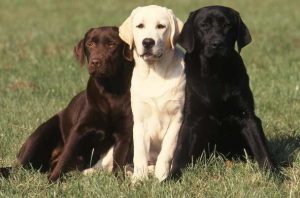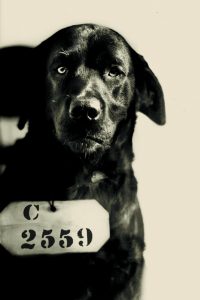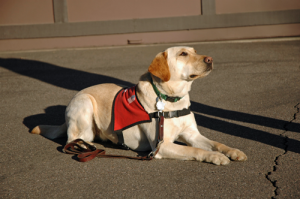Labrador Facts
The Labrador retriever isn’t from Labrador at all. Many breeds are named after the place of their origin, but the Labrador is an exception to this rule. The breed originated in the 1700s a bit south of Labrador, on the island of Newfoundland. It was known as the St. John’s dog, named after the capital city of Newfoundland.


Official breed standards Size: Labradors are a large breed. They should be as long from the withers to the base of the tail as they are from the floor to the withers. Males should stand 22.5 to 24.5 inches (57 to 62 cm) tall at the withers and weight 65 to 80 lb (29 to 36 kg). Females should stand 21.5 to 23.5 inches (55 to 60 cm) and weigh 55 to 70 lb (25 to 32 kg). By comparison under UK Kennel Club standards, height should be 22 to 22.5 inches (56 to 57 cm) for males, and 21.5 to 22 inches (55 to 56 cm) for females. 2 Coat: The Labrador Retriever’s coat should be short and dense, but not wiry. The coat is water-resistant, so the dog does not get cold when taking to water in the winter. That means that the dog naturally has a slightly dry, oily coat. Acceptable colours are black, yellow, and chocolate.3 Head: The head should be broad with slightly pronounced eyebrows. The eyes should be kind and expressive. Appropriate eye colours are brown and hazel. The lining around the eyes should be black. The ears should hang close to the head and set slightly above the eyes. Jaws: The jaws should be strong and powerful. The muzzle should be of medium length and should not be too tapered. The jaws should hang slightly and curve gracefully back. Body: The body should have a powerful and muscular build.
Whats in a Name
Labrador retrievers actually come from Newfoundland, not Labrador. In the 18th century, Greater Newfoundland dogs bred with smaller water dogs to produce St. John’s water dogs. These smaller canines looked a lot like modern day Labs, but with white muzzles and paws. The St. John’s water dog eventually went extinct, but it served as the ancestor for the Labrador retriever. The Earl of MalmsBury might have named them.
The Earl brought these dogs home with him to England after a trip to Canada, and referred to his new pups as “Labrador dogs” in 1887. Since Newfoundland and Labrador are geographically close, many historians suspect the name is a result of the British commonly lumping the territories together and referring to the whole mass as Labrador. Others believe the name was a nod to the fact that the dogs were often seen swimming in the Labrador Sea.4

After killing the cat belonging to Pennsylvania Governor Gifford Pinchot’s wife, a black Labrador retriever named Pep was sentenced to life without parole. The pooch was admitted to the Eastern State Penitentiary on August 12, 1924 and did about 10 years of hard time, during the course of which he became good friends with the warden. Although it sounds like an urban legend, prison records support the story. (Pinchot, for his part, said the dog was sent there to be the prisoner’s mascot.

Labradors are frequently trained to aid people who are blind and people with autism, act as therapy dogs, and perform screening and detection work for law enforcement and other official agencies.7
References
5 surprising facts about Labradors, retrieved:June 6, 2015
Retriever (Labrador) Breed Standard. The Kennel Club. Retrieved June 4, 2015
“Get to Know the Labrador Retriever”, ‘The American Kennel Club’, Retrieved June, 4 2015
“12 friendly faces about Labrador Retrievers” http://mentalfloss.com/article/63891/12-friendly-facts-about-labrador-retrievers, Retrieved June 6, 2015
“12 friendly facts about Labrador Retrievers”,http://mentalfloss.com/article/63891/12-friendly-facts-about-labrador-retrievers,Retrieved June 6, 2015
“Guild Assistance Dog Partners”, retrieved June 9, 2015
“AKC Dog Registration Statistics”. Akc.org. April 4, 2012. Retrieved June 10, 2012.
